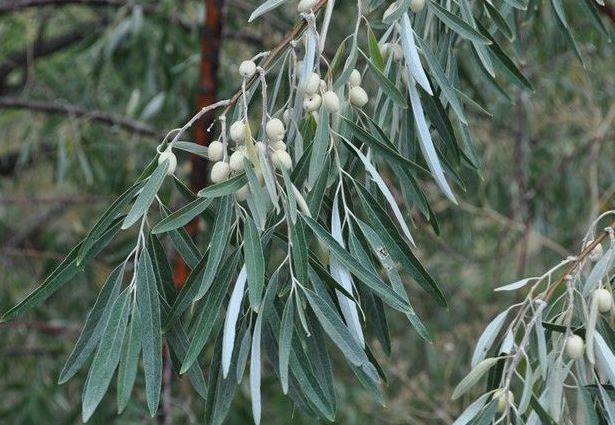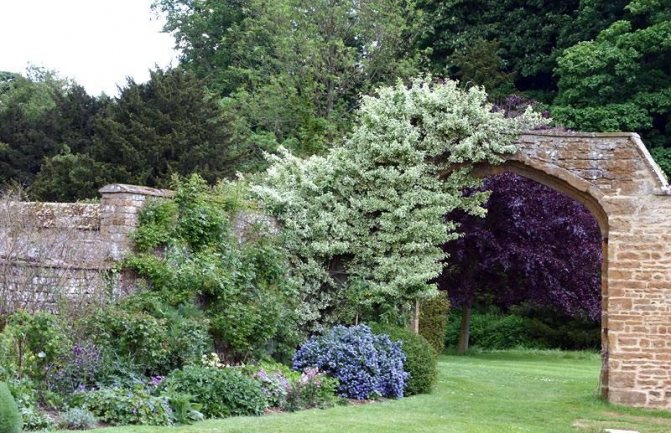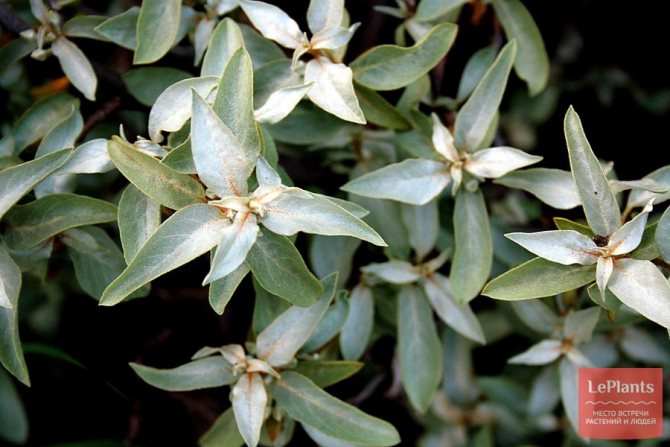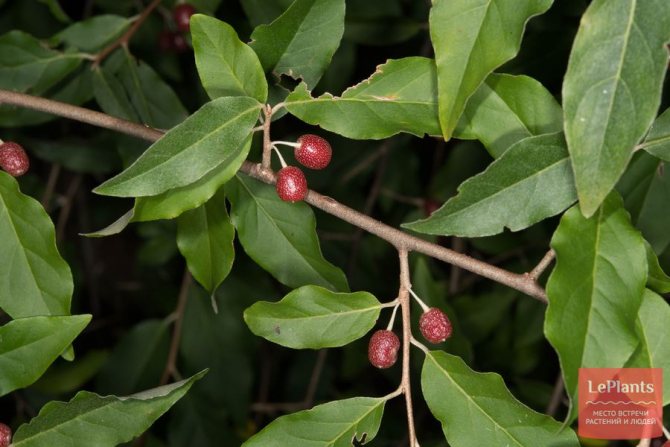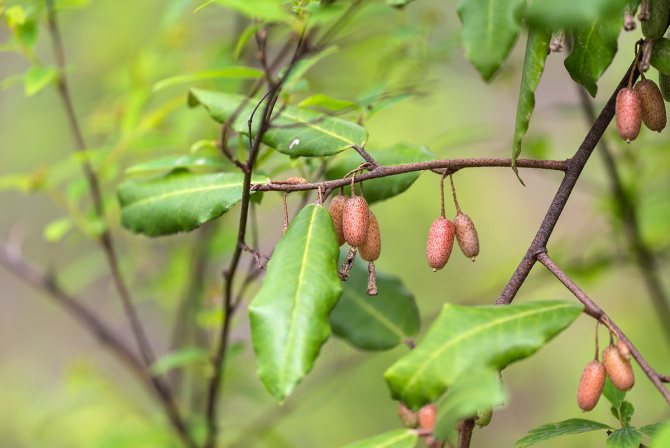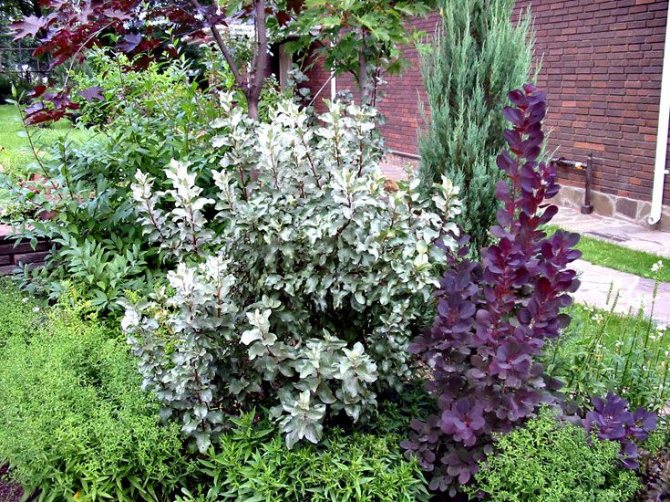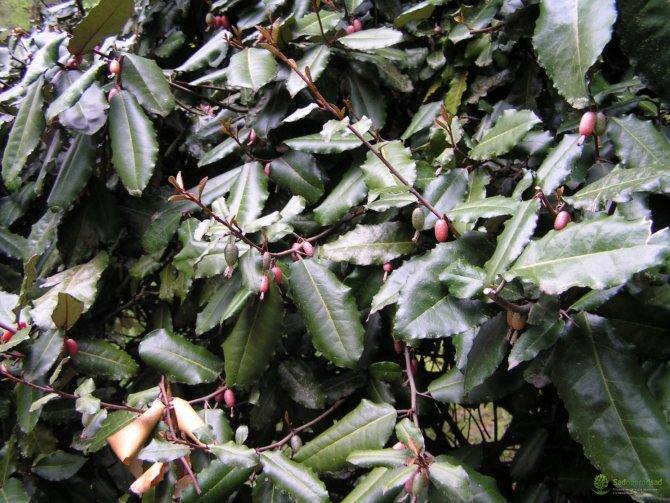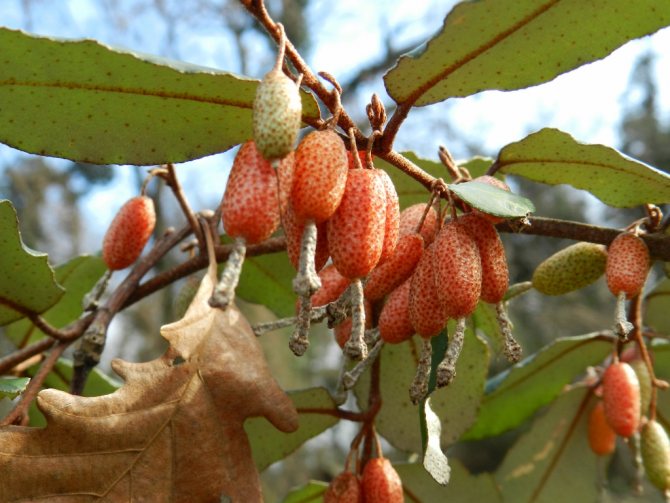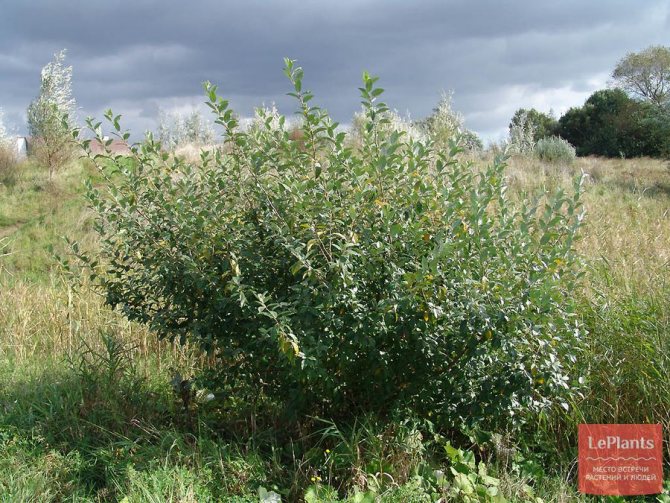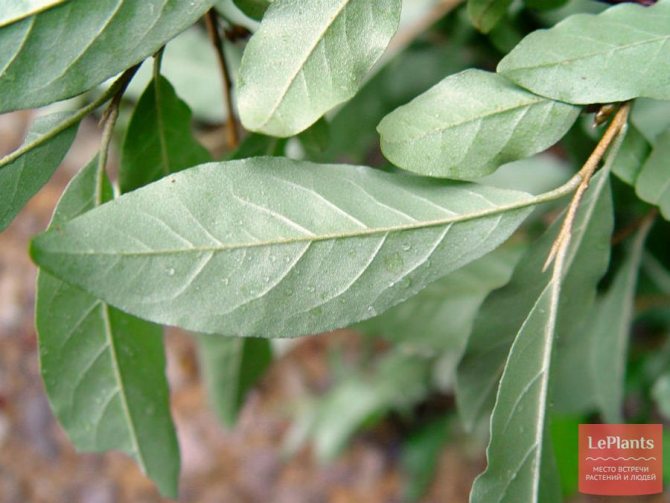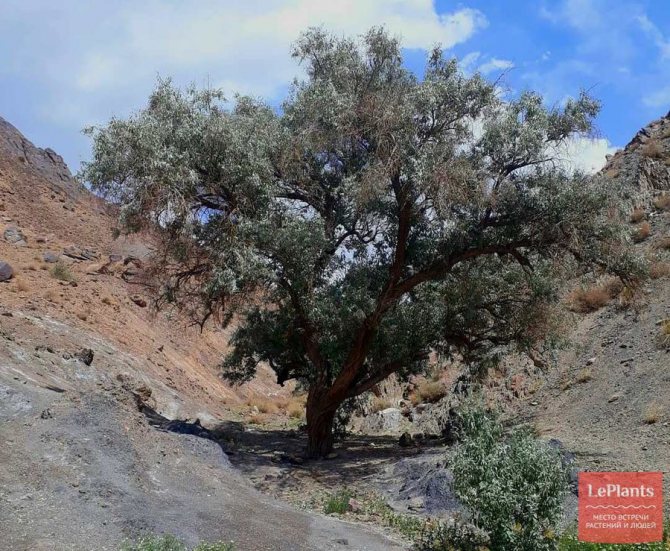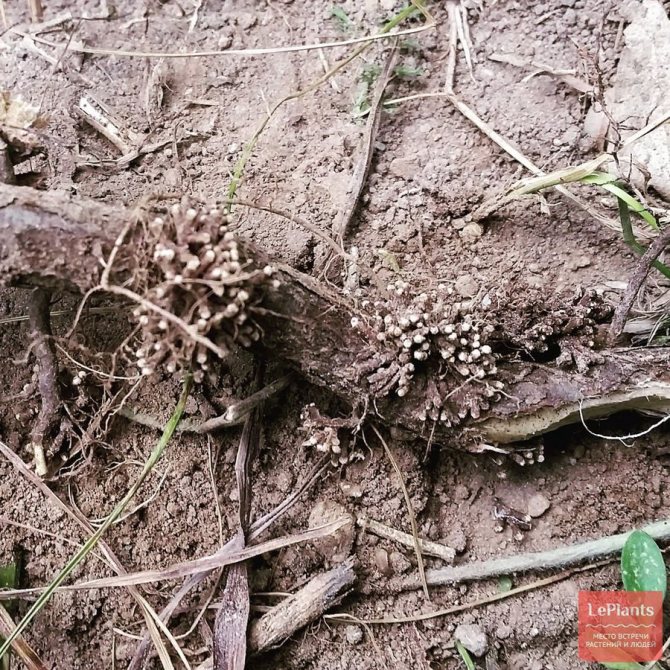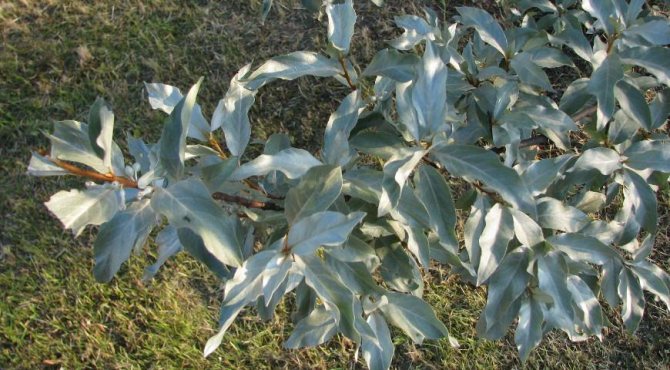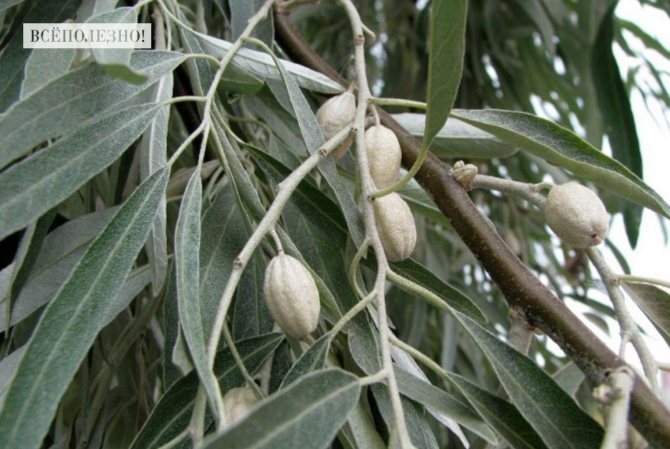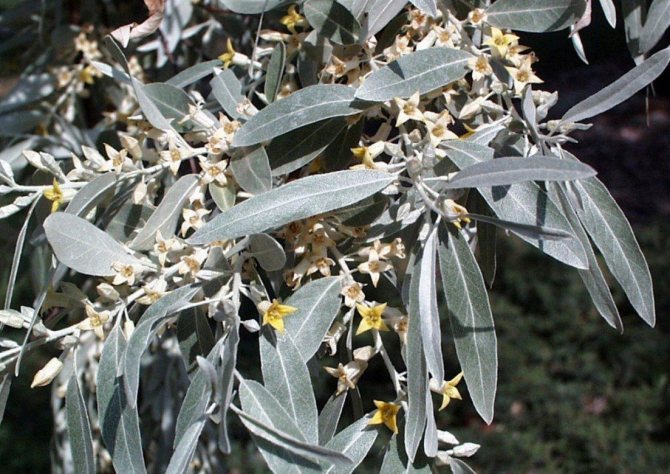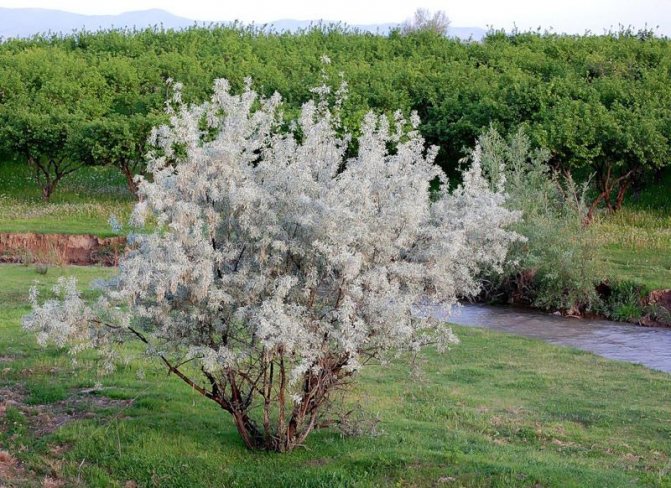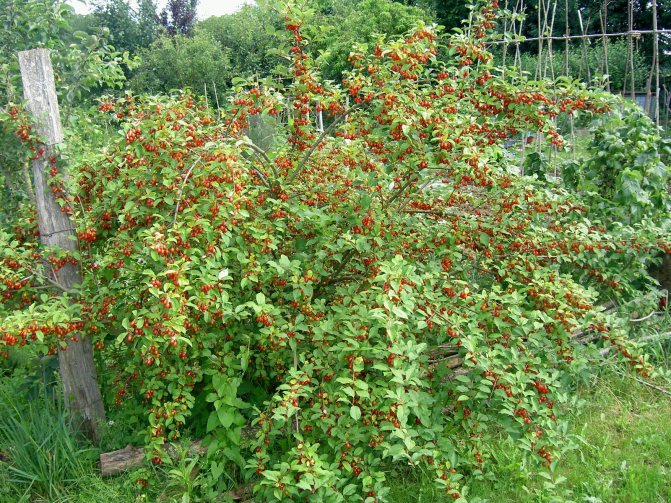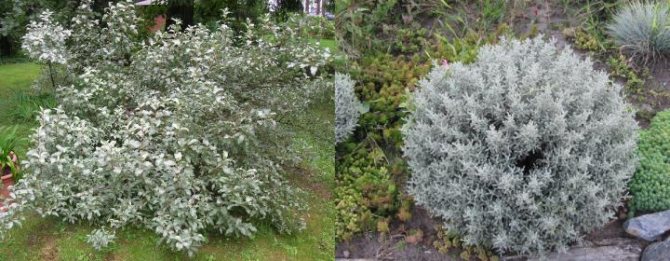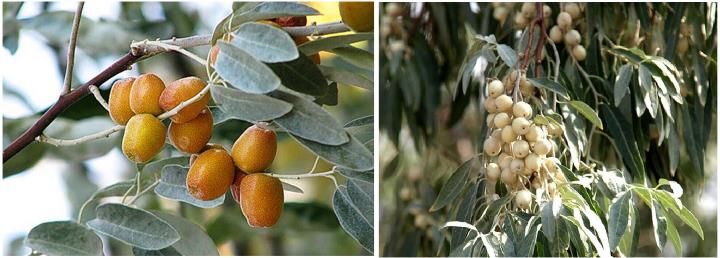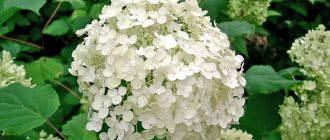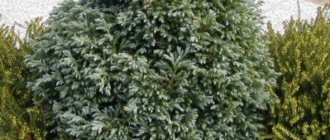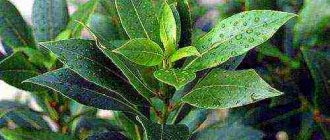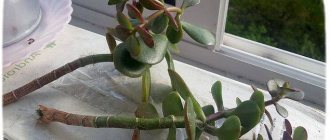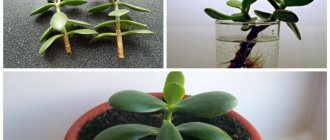Landscape decoration
Silver loch is an unusually beautiful plant. Its unusual, metallic leaves that retain their color until the very frost, abundant flowers with a pleasant aroma, bright, long-lasting fruits make this shrub incredibly attractive at any time of the year. Even in winter, gummi pleases the eye with its lush, gracefully curved branches. That is why silver goose is so prized in landscape design.
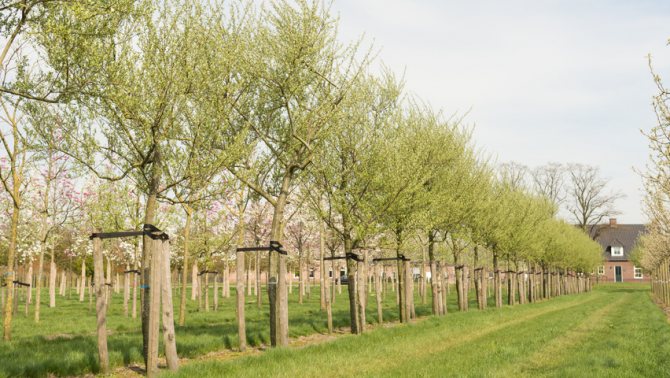
It is used to create contrasting color spots against the background of plants with golden or reddish leaves, as well as against the background of conifers. These color combinations are invariably pleasing to the eye.
A wild olive hedge is both powerful and graceful. It is easy to care for: once formed, it does not have to be pruned often. Groves, created exclusively from sucker bushes, look great on the site.
Wild olive in landscape design
The homeland of the decorative handsome man is recognized as the space of North America. For domestic regions, it is determined by a plant with exotic and excellent adaptive characteristics. Despite the need to discard the foliage, the ability of the wild olive to form numerous branches, forming a density of graceful lines, is used to create decorative compositions.
In the design of landscape spaces, loch is used to form single and group plantings, the effect of which depends on the presence of contrasting spots. At the same time, the decisive role in its use is played by the criteria: shape, growth, attractiveness of foliage and fruits. The silvery color of the leaves is appreciated as a unique backdrop that makes the vibrant color combinations of other plant elements even more dramatic.
A shaping haircut is one of the ways to control overgrowth and the ability to create an image of an object in accordance with the chosen design solution of the transforming spaces.
Top dressing and watering
Immediately before planting the plant, the soil can not be fertilized, with the exception of extremely poor, depleted soils. The next year, you need to introduce top dressing, including 8-10 kg of compost, 100-150 g of wood ash and 30 g of double superphosphate per bush. In summer, it is better to feed the silvery sucker shrub with mullein or bird droppings diluted in water.
During the dry season, the olive tree needs 30-40 liters of water per square meter. After watering, the soil should be mulched so that the moisture does not evaporate.
In the conditions of our country, the sucker is not susceptible to disease and pest attacks. Only occasionally, from an excess of moisture, the fruit can be affected by gray rot. To prevent this disease, the plant and the soil under it are treated with a solution consisting of 50 g of soda ash and 50 g of soap per 10 liters of water. Or use a solution containing 150 g of soap and 20 g of copper sulfate per 10 liters of water.
Landing, conditions
The plant is planted during the periods of early spring or late autumn. The soil must first be prepared:
- Dig up;
- Straighten with a rake;
- Remove weeds;
- Remove stones.
Important: Since the sucker has a fibrous root system that spreads shallow underground, soil preparation is of great importance.
It is preferable to plant the plant on an elevated slope on the south side near the house, which will protect the Loch from winter winds and frosts.
Soil for Loch silvery must be neutral, slightly alkaline, but not acidic... Landing pits are dug half a meter deep and more than a meter wide, they are placed at a distance of a couple of meters from each other. Drainage from stones or pebbles is poured into the bottom of the hole, then a mixture is laid out, including part of the soil, compost, sand and humus.
It is recommended to add mineral fertilizers to this mixture:
- 30-40 grams of nitrogen;
- 500-700 grams of wood ash or potash fertilizers;
- 200-250 grams of superphosphate.
When planting, the root collar is placed at a height of five to eight centimeters of deepening, then covered with soil, watered well and sprinkled with humus.
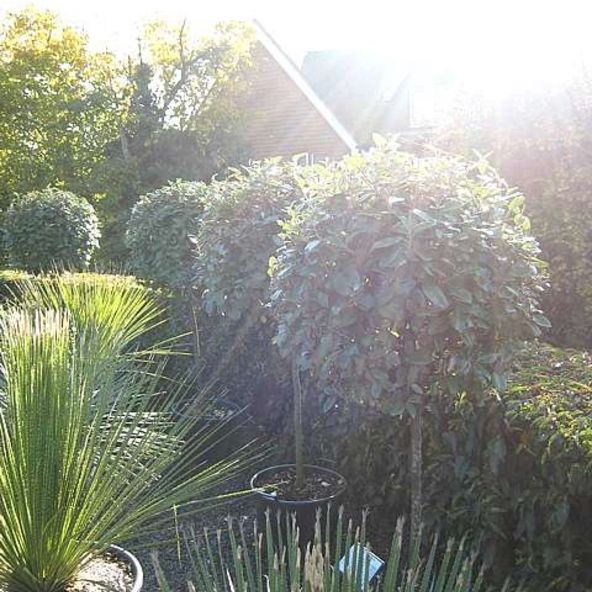

Agrotechnical characteristics
The yield of silvery sucker at first does not exceed four kilograms, but after two years you can get annually up to 30 kg of berries from the bush. This result can be achieved by ensuring cross-pollination of plants. To do this, you need to have two or three gumi bushes on the site. The crop is characterized by early maturity and annual yield.
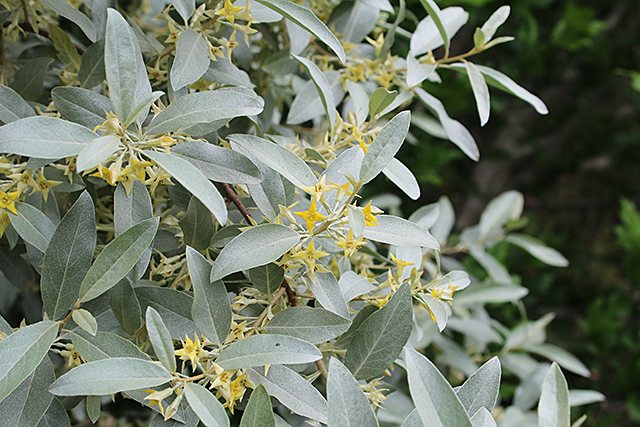

The root system of the plant is superficial. They are located at a depth of up to 40 cm. But in the horizontal direction, the roots grow one and a half to two times wider than their own crown. On the roots of gumi there are outgrowths formed by nodule nitrogen-fixing plants that saturate the soil with nitrogen. Therefore, the sucker is so undemanding to the quality of the soil. It can grow in the poorest soil.
Pruning
Wild olive produces a large number of root shoots, which must be disposed of in order to prevent impassable thickets around the plant and to maintain its neat appearance.
Pruning of the silver oak tree includes the removal of shoots that have frozen during the winter in the spring, and also makes it possible to form a crown like a standard tree. In addition, plants that have reached the age of fifteen should undergo cardinal pruning in order to rejuvenate. This can extend the life of the plant by ten or even fifteen years.
Gumi reproduces in different ways:
- dividing the bush;
- root suckers;
- seeds;
- layering;
- cuttings.
The easiest way is to propagate a wild olive by layering, taking advantage of the plant's ability to root branches lying on the ground. This planting is carried out in the spring. To do this, choose the strongest and healthiest from the lower branches, lay them in the ground, fix them, add them in drops and periodically water them a little. After three months, the cuttings form roots. It can now be shared with the mother bush just before planting in its permanent location.
Seed propagation is also not difficult. For planting, seeds are used that must be collected this season. It is best to sow them in the fall, from September to October. For the winter, crops should be covered with humus, sawdust or other materials.
Seeds of silver sucker can be planted in spring, however, their germination will be slightly less. Before spring sowing, the material must be stratified within three months at a temperature of +10 degrees.
Silver goose: description, photo
This thorny shrub with a medium spreading crown resembles a tree in appearance. The height of an adult plant reaches 4-5 m.
Every year the tree grows by 15 cm.
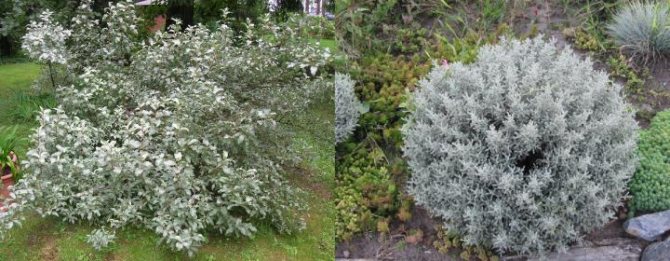

Its grayish branches are decorated with an openwork pattern, the leaves turn reddish in autumn. They are characterized by silvery scales and an oval shape. Shrub leaves, very similar to eucalyptus, stay on it until November.
In June-July, the silvery elk blooms for 20 days. The yellow flowers of the plant are round in shape, with a pleasant aroma. They are arranged in rosettes of three flowers in the leaf axils.
The plant begins to bear fruit 6-8 years after planting.The oval-shaped fruits are covered with silver scales, inside them are sweet mealy pulp. Because of the fruits, the shrub was nicknamed "silvery berries".
Subspecies and varieties of silver sucker
There are approximately 45 species of this woody plant. They can be found in Europe, North America, Asia. The only species is cultivated in Russia - silver goose. Along with it, there are other types of shrubs.
Narrow-leaved sucker also known as Jerusalem willow .
The height of the silvery sucker, which sheds foliage from itself, can be 10 m. This shrub bears fruit and bears edible fruits, is immune to drought and tolerates winter frosts.
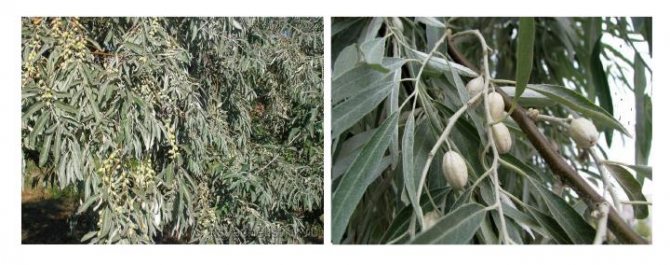

Multiflorous sucker of Chinese and Japanese origin Is a fruit and berry shrub that rises to a height of 2 m, blooms in May, bears fruit, ripens in early autumn and is vulnerable to frost and prolonged cold weather.
Reproduction methods
Can be propagated silver goose
- seeds;
- cuttings;
- layering;
- root suckers;
- dividing the bush.
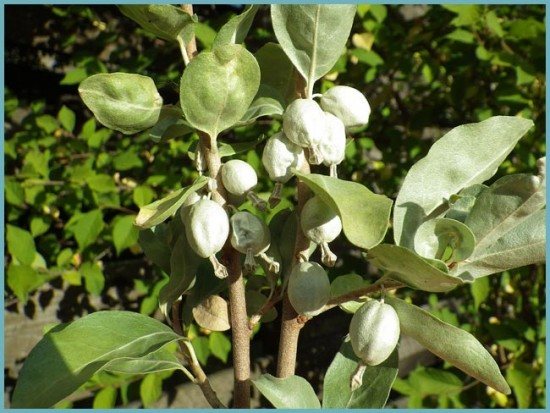

Seed reproduction most popular. Sowing is recommended in autumn - in September or October. Freshly harvested seeds show the best germination, but in general it lasts up to 2 years. It is recommended to mulch crops with sawdust, humus or other material for protection from the cold. However, you can sow in the spring, but this is more laborious, since seedlings will not appear without stratification. This process in suckers is quite long - more than 3 months, the temperature should be maintained at about 10 ° C all this time.
For getting layering, in early spring, a healthy shoot is chosen, located in the lower part of the crown. They bend it to the ground, pin it and cover it with soil. Water moderately during the growing season. At the end of the season, a new plant will form, ready for separation from the mother.
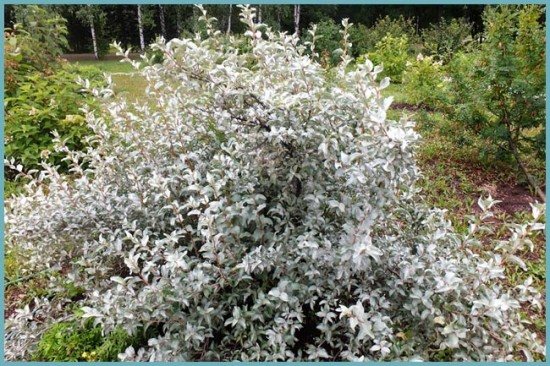

Reproduction cuttings it is quite difficult, according to the reviews of experienced gardeners, only 30% of the planting material takes root. Cuttings are harvested in the summer: shoots are cut about 15 cm long with four leaves. Before planting, they are treated with root formation stimulants. Rooting is carried out in wet sand. It is convenient to place the cuttings in a box, since they need to be stored indoors for the winter, or in a cellar, preferably at a temperature of 3-5 ° C.
Silvery loch is a completely undemanding plant to care for. Its flowers have a pleasant aroma, the plant serves as an excellent honey plant. Among other things, it can enrich the soil with nitrogen. You can successfully decorate with it small areas, you just need to control the root shoots.
Loch silver: video
To plant a silvery sucker on a plot means to decorate your garden with an unpretentious silvery shrub that brings original vitamin fruits. It looks great from spring to autumn, shimmering with matte silver of elongated leaves. The shrub retains its decorative effect in winter, surprising with its bizarre interweaving of dense shoots. It looks good both as a tapeworm and in a group planting.
Plant species
narrow-leaved goose bush
The Loch genus unites about forty species of plants, both trees and shrubs. Their leaves resemble silver in color, therefore the plants have a high decorative value.
To date, in the process of selection, five basic forms of the variety have appeared:
- silver (E. angustifolia) - its homeland is considered to be the east of the North American continent;
- multiflorous or Gumi (E. multiftora) - spread throughout the world from Japan and China, very popular due to the appearance of delicious red berries;
- (E. angustifolia) narrow-leaved oak in the Moscow region, it is not yet found very often - it mainly grows in the southern part of Russia, Kazakhstan, the Caucasus and Central Asia (where its "brother" Loch of India is also found) in general, where warmer;
- Loch umbrella useful properties, which are invaluable and scientifically proven, chose East Asia as a habitat;
- prickly (E. pungens) - appeared as a species in Japan. It has ripe brownish-red fruits, which adds charm in the autumn. The most popular variety is the golden goose (f. Aurea) with a yellow stripe along the leaf.
There is an erroneous opinion about the existence of another species in the Lokhovye family - Loch Chilean
, which does not exist in botany.
Popular varieties
According to some sources, there are 40 varieties in total. According to other sources, there are 98 types of shrubs and 331 varieties (including synonyms). The following varieties take root well with us.
Umbrella view
This species grows in large numbers in Central Asia, as it does not tolerate low temperature conditions. If you plant a seedling at -5 C, it may take root. However, if the temperature drops to -10 C, the plant will definitely die.
The trunk can grow up to 4 meters. The shaggy foliage cap expands to 160 cm. The leaves are light green. In May, the buds of a yellowish-silvery color bloom, bees like it very much.
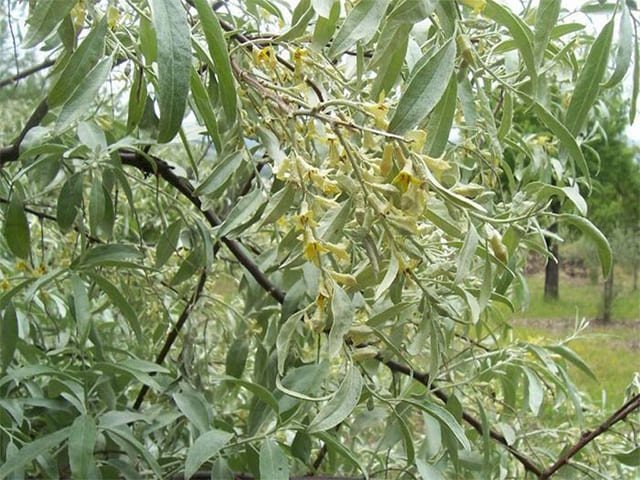

The berries usually appear on the tree when it is 9 years old. They are not oblong, round in shape. The fruits have beneficial properties.
Prickly
Also called thornleaf. It is classified as evergreen. It grows up to 7 meters. The leaves are oblong-elliptical with wavy edges. Below the greenery is silvery-brown, and above it is dark green and shiny. On the side of the branches, shoots can grow, which begin to cling to the surrounding objects.
The flowers of the bush are silvery-white on top, golden in the middle. They appear in 2-3 pieces and smell very tasty. Fruits of a greenish-brown hue grow from the flowers. When ripe, they begin to blush. Due to its amazing beauty, it is often grown for landscaping.
Multiflorous species
It grows only up to 1.5 m, there are no thorns. Wood with brownish-reddish scales. Leaves are oval, slightly oblong. Above are silvery-scaly, below are silvery-brown.
In June, flowers appear white with a yellow tint. They look like a bell. Red berries appear in August.
Type silver
The homeland of this variety of bush is North America. There are no thorns on it. Leaves are leathery, below the scales are brownish.
The flowers are yellowish white. They bloom in the middle of the summer season, bloom for almost 20 days. A plant that is more than 8 years old has berries instead of flowers. They fully ripen by the first month of autumn.
The silvery sucker, unlike other species, does not tolerate dry weather well. But it is more resistant to frost. The shrub grows very slowly.
Narrow-leaved species
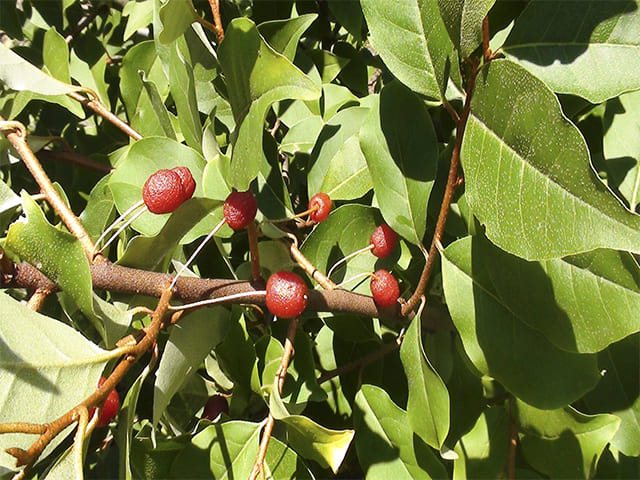

Under natural conditions, this species is found on the shores of rivers and lakes in Central and South Asia, Kazakhstan, the Caucasus and in the southern zone of the Russian Federation. It can also be called Jida (the same tree, but grown as a cultivated one).
It can grow up to 10 m upwards. Refers to deciduous. Its bark is reddish-brown with silvery scales. On the branches there are spines up to 3 cm long, lanceolate leaves up to 8 cm. Above, light green, and below, silvery-white scaly.
The flowers of the shrub are yellow on the outside, silvery inside. After 20 days, a fruit appears in the place of the flower. It changes its color from silver to yellowish brown.
The plant has a deep rhizome. In this regard, the shrub is resistant to drought and frost. It takes root well in large cities with poor ecology.
Care in the process of growing
After planting, the plant should be cared for. The plant can grow well in any soil, and the impact on it of pests and diseases characteristic of our climate is minimal. For full growth and development of the sucker, it should be watered regularly, the soil around the trunk should be loosened.Loosening can rarely be carried out if the soil was mulched with sawdust or dry grass before planting.
Watering the plant


The plant belongs to drought-resistant species, but despite this, you should not take long breaks between waterings. Regular watering of young bushes is especially important. Watering is important based on the type of plant root system: since the roots are closer to the surface, they do not reach groundwater, therefore, they may suffer from a lack of nutrient moisture. In this regard, if there has been no rain for a long time or there is intense heat, the plant should be regularly watered. Watering should be moderate, water should not stagnate in the soil and on its surface. If there is an excess of water, the roots will begin to rot. Top dressing
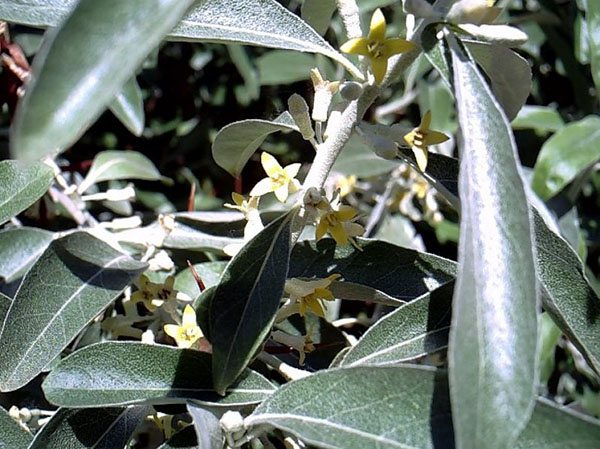

Top dressing is required for shrubs only when it grows on very poor soil. And so, as a rule, they fertilize the plant at the time of planting the plant in the ground. Further feeding is recommended to be done once a year. For this, organic fertilizers are most suitable - humus, compost. You can also use superphosphate. It is not recommended to take nitrogen compounds.
Reproduction methods
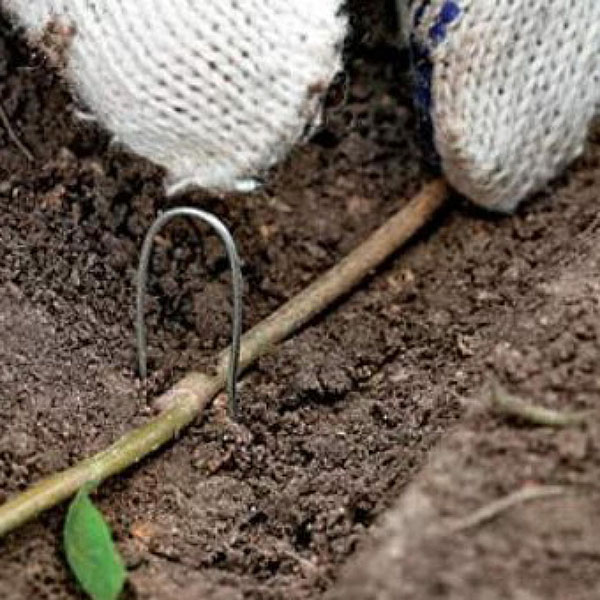

The plant can reproduce by cuttings, seeds, dividing the bush, parts of the rhizome, branching.
Disembarkation and leaving
Planting a silvery sucker
The plant is very light-requiring and needs a well-lit area that is reliably protected from the wind. Best of all, silver goose grows in elevated areas near buildings.
The tree can also be planted near roads: it is invulnerable to strong dust and smoke. The shrub of the silver sucker is afraid of highly acidic soils, therefore, the acidic soil on the site must be diluted with lime.
The plant is good because it is not necessary to feed it: the goose improves the soil on which it grows!
A feature of the shrub is the fibrous root system located on the surface of the earth.
- Before planting silvery sucker, the territory for it must be dug deeply, clearing it of litter, stones, weeds.
- After digging, the soil should be leveled with a rake.
- The holes for the plant are dug up to 1.5 m wide and buried by 0.5 m.
- At the bottom of the pits, drainage from rubble and expanded clay is arranged so that water does not stagnate, which is a threat to the roots of the sucker.
- It is necessary to add compost or humus to the holes.
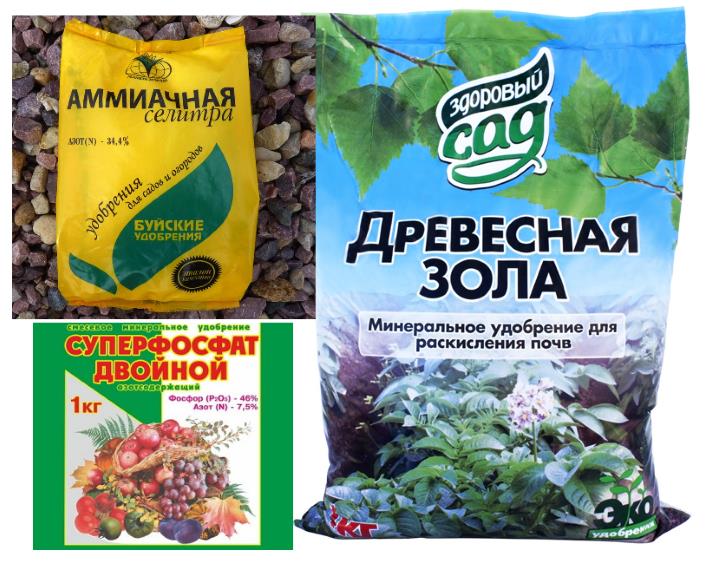

As a fertilizer, you can use a mixture of:
- 30 g of nitrogen compounds,
- 200 g of double superphosphate and
- 500 gr of wood ash.
Silvery sucker is planted in early spring, and in late autumn, when the soil is moist enough and the seedlings take root well.
It is optimal to plant them at intervals of 2-3 m, deepening the top of the rhizome by 5 cm.
Planted shrubs should be watered generously and the surrounding soil should be covered with mulch. This will ensure that moisture is retained in the ground on hot days, and also prevents the development of weeds.
Silvery sucker care after planting
It is very important to water the shrub regularly, especially on hot days.
When it rains, the plant gets enough water. Due to the fact that the silvery sucker feeds the soil itself, you do not need to feed it. But in order for the bush to develop better, abundantly and often bloom, the soil with the shrub should be enriched with wood ash and double superphosphate.
There is no need to feed seedlings barely planted in the ground. This plant is winter-hardy, but at very low temperatures, its shoots sometimes die. In order to avoid damage to the shrub, it must be insulated.
Insulation of the bush
For this:
- when the fruits are collected from the bush, it is surrounded by pegs, which are driven into the ground;
- the pegs are carefully bent to the ground and fixed;
- the plant is covered with dry leaves, straw, sawdust and tied with foil.
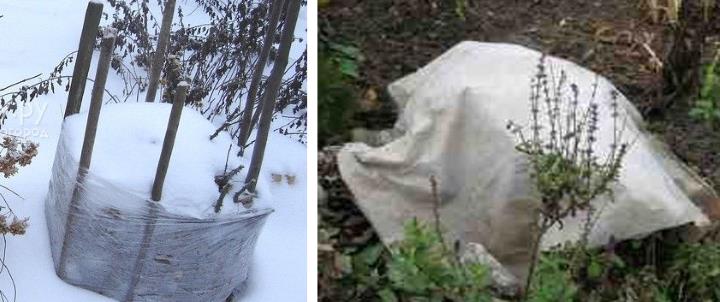

Under such a cover, which is visible in the photo, the silvery sucker shrub is reliably protected from severe frosts until spring, at the beginning of which it is necessary to remove the insulation from it in time. Otherwise, deprived of air and under the influence of condensation, the silver goose will begin to rot.The best time to shoot the film is at the end of April.
For a more aesthetic appearance of the shrub, it is necessary to control the growth of its root growth. The haircut of the silver elk tolerates well, and it helps to form a bush. If the plant is correctly placed on the site, all the rules for caring for it are followed, then by 5-6 years it begins to bear fruit.
At first, the silver sucker has few fruits - up to 4 kg, but after a couple of years you can count on a harvest of up to 30 kg of berries annually. The fruit of the plant tastes unusual, resembling pineapple and cherry. They are prized for their healing properties and richness in vitamins.
Berries are suitable for freezing, drying and fresh consumption. They make jam, compotes, juices.
Reproduction of silvery sucker
The plant is propagated:
- cuttings, dividing the bush into several,
- root suckers,
- seeds and layering.
Propagation by cuttings
This method of reproduction of silvery sucker is risky: usually no more than a third of the cuttings take root. Planting material is prepared in summer.
For this purpose, the shoots are cut into pieces about 15 cm long each, leaving 4 or more leaves on them. The cuttings are cut with crushed coal, after which the cuttings are immersed in solutions "Kornevin" or "Epin».
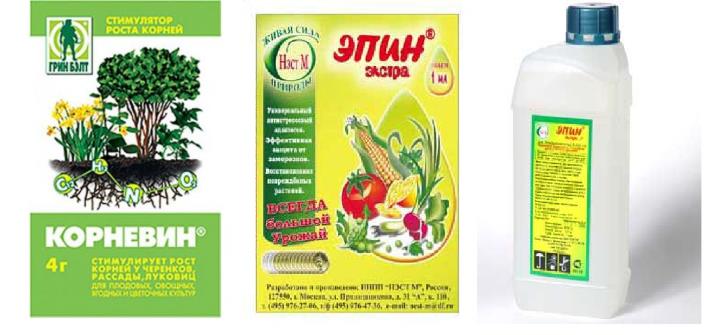

Since planting material is stored indoors on winter days, it is better to plant cuttings in containers filled with damp sand. The temperature in the room where cuttings take root in winter must be maintained within 3-5C.
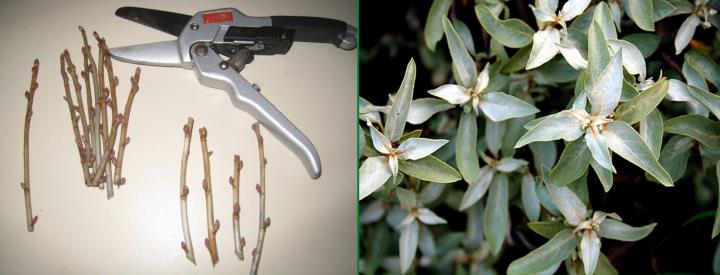

Reproduction by layering
This method allows the plant to propagate in early spring. At the bottom of the bark, a healthy shoot is chosen, bending to the ground, and pinched with wire. The layering is covered with earth and watered. It is easy to care for it - just water it so that the ground is not too wet and does not dry out. The new plant is separated from the mother at the end of spring.
Shrub propagation by seeds
Using this method of plant propagation, freshly harvested seeds are sown in September-October. You can plant them in the spring, if stratified before planting. Seed stratification continues for three months at a temperature of 10C. Autumn seedlings protect from the cold, covering with humus, foliage, sawdust.
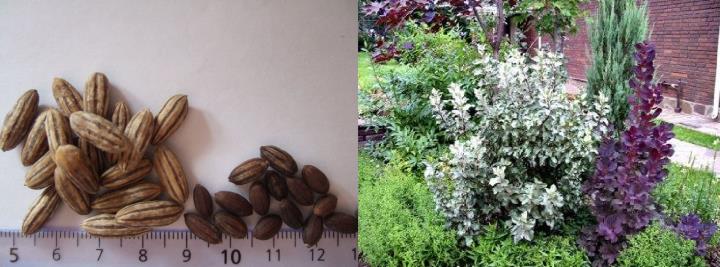

Frost resistance
The silver oak tree is unpretentious. It is quite resistant to frost, with the exception of the upper part of young shoots, the wood of which does not have time to fully ripen and freezes over the winter.
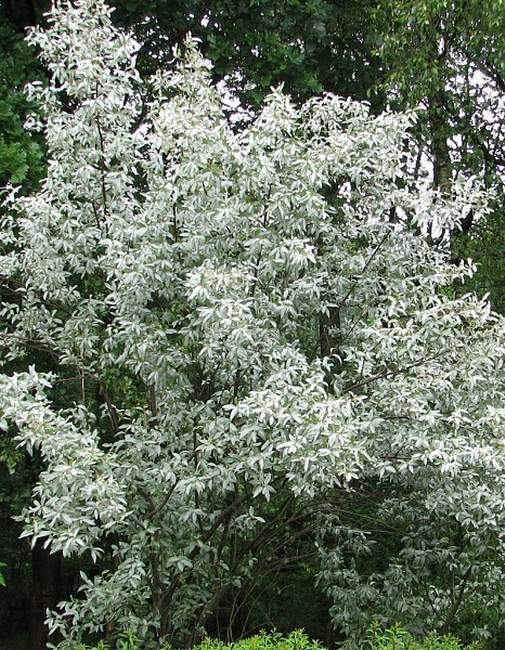

This property is compensated by the good restorative qualities of the plant and the ability to form many new shoots. To protect the bush from frost, its young shoots are tilted to the ground and fixed so that in winter the snow completely covers them.
You can also cover the shrub with spruce branches, straw, brushwood, dry leaves, or sawdust. It is important not to use dense materials for this - burlap or polyethylene. This can lead to damping and decay of the plant.
Description of the tree
Loch is a small, deciduous tree with a wide and spreading crown. The bark is red-brown in color, there are thorns, it reaches 3 centimeters in length. The trunk, during the growth period, takes on a curved shape. The tree produces pubescent young shoots with a silvery shade. Possesses a powerful and strong root system.
Foliage. The shape of the leaves is oval, reminiscent of laurel, narrowed at the base and pointed at the top. The bottom is white, and the top is gray-green. The surface is covered with scales. On the tree, the leaves are held by cuttings, the length of which is 4-7 cm.
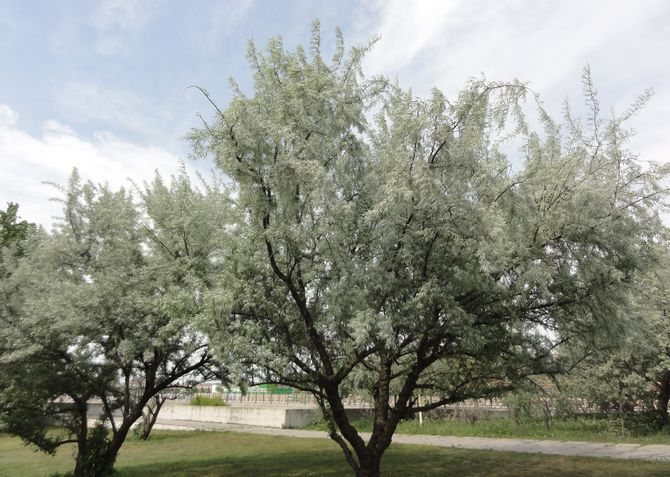

Flowers. The tree blooms with single, small flowers. Their inner part is orange-yellow, the outer part is silvery. They have a strong aroma and a lot of nectar. Flowering falls in June, lasts up to 20 days.
Fruit. From August to September, the fruits begin to ripen. It is an oval or spherical drupe with a sweet taste and reddish-yellow color.The weight of the fruit is about 3 g, the length is 1 cm. The ripening process is uneven, but those fruits that are already overripe are still on the branches for a long time. For full ripening, the fruit of the sucker needs a long warm period. A plant that has reached 3-5 years old begins to bloom and bear fruit.
Useful properties of silvery sucker
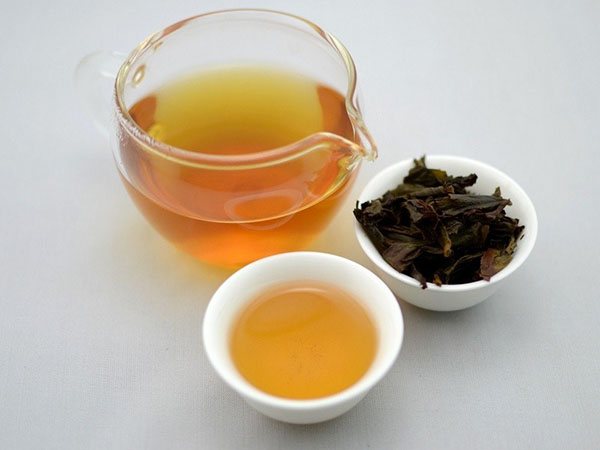

Most often, traditional healers use bush berries. In addition to the general strengthening effect, they also improve memory and cope with diseases of the gastrointestinal tract.
Throat rinse
This infusion will help not only cope with the inflammatory processes that occur in the oral cavity, but also relieve respiratory diseases.
To prepare it, you must:
- 1.5 tbsp. l leaves (both fresh and dry);
- 1 tbsp. boiling water.
Put the raw material in a container and fill it with water. Cover the top tightly with a lid and keep at room temperature for 3 hours. This time will be enough for the plant to give up all its healing substances.
At the end of the time, strain the liquid through cheesecloth. Take 50 ml three times a day. Drink after meals.
Tincture for hypertension


People who suffer from rheumatism will need fresh sucker leaves. You only need to use them once. Repeated use of raw materials will not give the desired result.
For the preparation of poultices, take 100 g of freshly harvested leaves. For 20 minutes, the raw materials are kept in a water bath, and then folded into cheesecloth in the form of a small pillow. Apply the workpiece to the sore spot for 30 minutes.
The fruits of silvery sucker will help get rid of high body temperature. A decoction is made from them according to the recipe for rinsing the mouth. They drink the prepared product or make lotions from it. Drink the broth no more than 3 times a day.
You can keep the finished broth for no longer than two days. After this time, it is recommended to prepare a fresh product.
Where is the goof tree applied
Its leaves, flowers, bark and fruits are used for medicinal purposes. Scurvy, heart disease, edema and colitis, for all these ailments, decoctions and infusions made from sucker flowers are recommended. Medicinal infusions from the leaves of the plant can help with gout, during an attack of rheumatism and heal wounds.
Leaves and bark of the plant act as natural dyes for leather, they give black and brown color. The fruit of the tree can be consumed and used in cooking. Various musical instruments can be made from wood, and the loch also serves as a material for the production of furniture and all kinds of carpentry products.
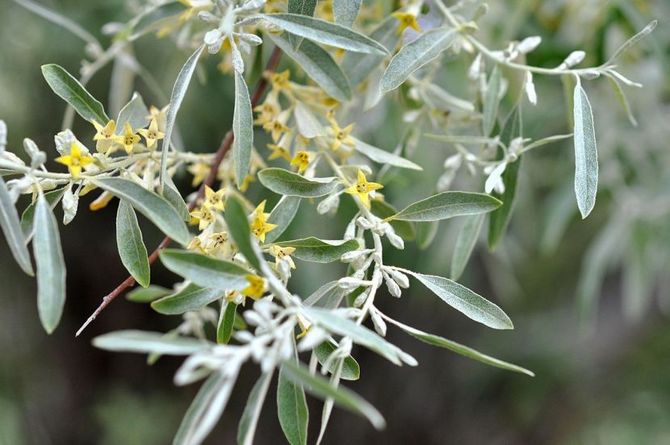

This is a wonderful melliferous plant. Honey from the nectar of sucker flowers turns out to be of a beautiful amber color and has an amazing aroma and pleasant taste. The tree can be used for single plantings, as well as group. Well suited for landscaping any area, haircut is easy. It can be used to strengthen the soil.
Looks great as an ornamental plant, due to silvery leaves, bright bark, yellow flowers and red fruits.
Deciduous Trees Garden: Trees and Shrubs
Growing conditions and varieties
Lohovnik loves well-lit areas, is quite unpretentious, undemanding to the nutritional value and composition of the soil, tolerates frosts down to -40 ° C and may well be grown in temperate or continental climates, on rocky soils and sandstones. The shrub has a lifespan of 25–30 years.
The varieties of the silver goofer are:
- narrow-leaved oak: a tall, dense frost-resistant shrub with elongated leaves 1.5–2 cm wide, yielding edible fruits;
- multiflorous oak (gum): a low-growing plant with a height of about 1.5 m with bright green foliage and red fruits, found in China and Japan.
Lokhov wood has high technical characteristics. The width of the logs reaches 30 cm. The sapwood is pale yellow, the core is slightly darker.The massif is wide-layered, does not crack or deform when dried. The density is 670-710 kg / cubic meter.
Planting work
When choosing a site, it is better to opt for a well-lit place without shade, but partial shade is also possible. Elk is undemanding to the composition of soils. If possible, try to protect the plant from icy winds. Soil preparation consists in deep digging. If necessary, lime or dolomite flour is added on acidified substrates. On very heavy and swollen soils, sand is added to improve the structure.
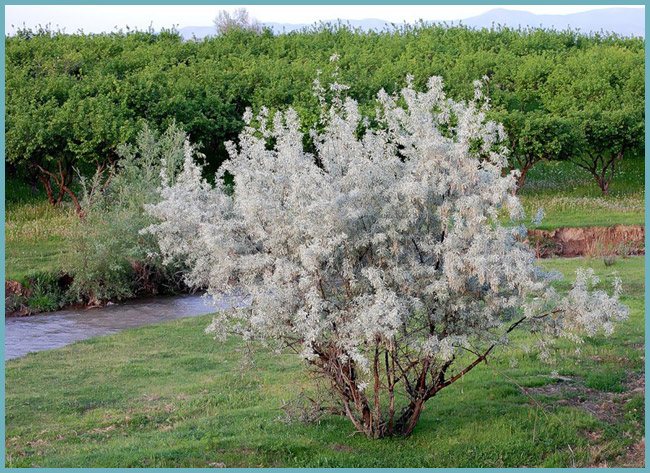

Silver goose is a very undemanding plant
Planting can be done both in spring and autumn. A planting pit 50 x 50 cm is prepared, where fertile leafy soil, compost or humus are introduced. If the soil is clayey, with the danger of stagnant water, a drainage layer is arranged at the bottom of the pit. Crushed stone, broken brick and other materials are suitable for this. The root collar of the seedling is slightly deepened (by 5-8 cm), the planted plant is watered abundantly, mulched with grass mulch, compost, sawdust.
Loch melliferous plant
In addition to all of the above benefits, this plant is an excellent honey plant. The honey obtained from its flowers not only has a unique taste, but is also extremely useful. Medical studies have confirmed the beneficial effect of this composition on the state of blood vessels and the functioning of the brain, on the functioning of the liver, as well as its anti-inflammatory, cleansing and restorative properties. And just like other medicines, this honey does not cause allergies.
